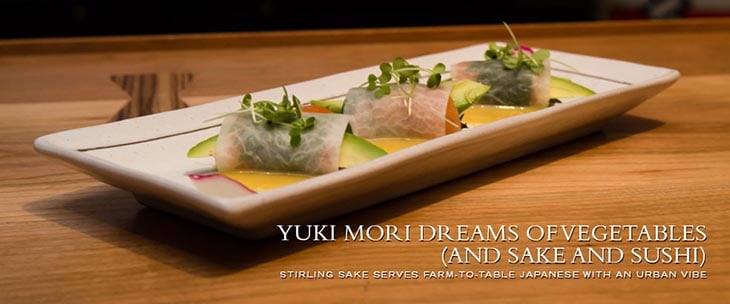These days it seems as though every new restaurant in this country is eager to establish its farm-to-table creds. Yet if the restaurant is Japanese and the chef is ambitious, nationalist pride trumps local produce almost every time. (Certain celebrated chefs have even been known to import tomatoes from the motherland.) Stirling Sake and Sushi, in Greenport, is a notable exception to the rule.
“I was attracted to the area because it was very green and had fantastic farmland and, of course, fish,” said first-time restaurateur and sake sommelier Yuki Mori, who moved from Brooklyn to Greenport last March. Previously at Decibel, a sake bar in Manhattan’s East Village, Mori first heard about the North Fork from one of his sake distributors. “As soon as I saw all the farms out here, and the incredible fishing, I realized I could open a sake bar and sushi restaurant that used mostly local products.” Once he found a home for the restaurant, Mori began searching for a plot of land for a kitchen garden. You know it’s a sign of a restaurant’s priorities when the owner is dreaming of his first season’s crops before the cherrywood bar has been installed, before the olive-green paint has dried on the walls, before a single customer has walked through the door. “By next spring I hope to be planting edamame and shiso and small Japanese eggplants and cucumbers, daikon root, and burdock,” Mori said on a recent afternoon before dinner service. And yet for all his love of rural living, Mori brings a distinct New York sensibility to Greenport. “We have a city vibe,” he said, “and we serve sake and sushi as though we were in Brooklyn.” Or the East Village, which is where he met his chef, Akio Kon, who worked alongside chef Nobu Matsuhisa at a restaurant in Lima, Peru, before Matsuhisa achieved international renown.
“Akio Kon was one of my customers at Decibel,” Mori recalled. “He’s an accomplished fisherman and he was always stopping by with just-caught fish.” It didn’t take much to persuade the chef to relocate to an area he’d been coming to for twenty years and where he could go fishing whenever he liked. Right now, that means every Tuesday. Depending on the day’s catch, the freshest black bass or porgies or a bluefish might turn up at the sushi bar. Like many Japanese fishermen, Kon is a skilled practitioner of ikejime, a quick way of killing fish–by inserting a spike into the brain–that results in exceptionally sweet, succulent flesh. The restaurant also buys fish from Braun Seafood in Cutchogue.
Kon has kept the food simple. A meal might begin with ceviche of striped bass or a salad of wakame seaweed and local greens, lightly dressed with a sesame vinaigrette. The sushi is always changing, and there are three kinds of noodle soups on the menu. The sake menu, by contrast, is incredibly elaborate and includes cryptic annotations. Mori offers twenty different sakes by the bottle or glass. There’s Shusen Jumnai Ginjo, a “big-boned sake” and a bargain at $10 a glass, and Suigei Jumai “sharp and cuts like a samurai sword”. Aware that the subtle nuances and variations of fine sake can be hard for westerners to grasp, Mori plans to hold a series of educational workshops that will feature tasting flights. Since the restaurant has been open it has found favor with a lot of year-round residents. Some of the regulars are local vintners. “As it turns out,” Mori said, “people in the wine trade are really interested in premium sake.”









